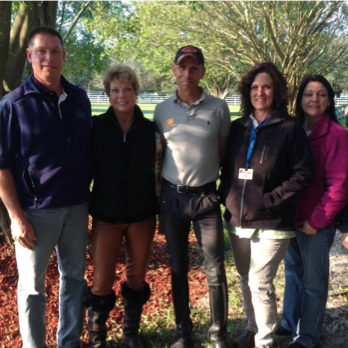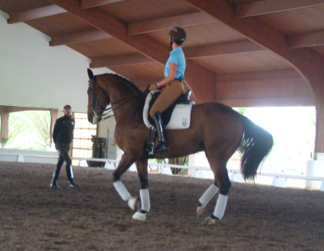 |
| Pearls of wisdom taken away from the USDF FEI Trainers’ Conference with Steffen Peters and Scott Hassler |
From LYNN LEATH:
|
* Engage the horses mind
* Horse must go RESPECTFULLY forward
* Give horse a job in the walk
* Make sure horse understands each and every aid
* Happy mouth - happy horse
* Use UPPER calf as a gentle pressure as your driving aid - TEST!
* How little aid can you use to get the response you want?
* TEST - how little aid can you use? How cooperative is your horse? How much effort?
Rider less - horse more = PERFECT!
|
Don’t use spur to MAINTAIN or SUPPORT -- use instead to REMIND him.
Steffen’s goal is to make the horse SIMPLE to ride and to OFFER the movement |
When are we satisfied? Use horses HIGHLIGHTS to develop WEAKER things |
* Horses have SIX gaits (not 3). Develop exercises to ride weaker sides.
* Don’t ignore work on the walk - work on it so that horse understands what is expected - not restricting - do not overwork.
* Ride PRO-active vs RE-active. Stay ahead - ask questions - get reactions.
* INSPIRE (put energy) in your horse with micro-aids. |
Create a DANCE |
Canter - Use CENTER LINE to learn how AVAILABLE and SIMPLE it is to get straightness. |
* Horses have SIX gaits (not 3). Develop exercises to ride weaker sides.
* Don’t ignore work on the walk - work on it so that horse understands what is expected - not restricting - do not overwork.
* Ride PRO-active vs RE-active. Stay ahead - ask questions - get reactions.
* INSPIRE (put energy) in your horse with micro-aids. |
* An exercise to develop canter pirouettes: B to C - on centerline near C - pirouette and come out heading toward E. E to A - on C/L near A - pirouette and come out heading towards B.
* An exercise to help use inside hind - Travers in walk -- even bend throughout body - directly into canter depart.
* Always check the STRAIGHTNESS and SIMPLICITY of aid
* Trot half pass - begin with cadence and then push the trot forward
* Horse’s neck needs to be where rider has control. Find the most productive frame for each horse.
* Use travers in canter to get more engagement but not smaller circle.
* Perfect time to start (lateral) bend in the canter pirouettes is just when you begin the turn.
* It is the FIRST reaction (to the aid) that we are interested in.
* When a muscle is rigid - there is no sense holding onto it
* Prep for (canter) pirouette: combination leg yield/shoulder in on centerline -- leg yield to 1/4 line -- 1/2 pirouette back to center line. Sensitivity to INNER leg = control.
* Don’t compromise on the little things. Expression, suppleness, straightness, SIMPLICITY.
* Encourage the horse to OFFER the movement.
* When introducing the one time tempi changes - don’t canter for too long. Pick up canter - do 2 to 4 ones - and then walk. If slow to change to one direction - go back and work on that single change - then go back and work on singles.
* Steffen is a big fan of working walk/passage and trot/passage transitions.
* How much HELP does the horse need?
* Piaffe to passage transitions - open upper leg and close lower leg.
* Leg position - the riders toe under the knee is always better
* Do flying changes on the rail to prevent drifting
* Begin the canter pirouette - and then think bigger and more forward. Outside leg not too far back.
* Make PERFECT SENSE with your aids
Show your best (walk, trot, canter) the FIRST step of the transition |
| |
From KAREN ALLRED:
|
* Keep it simple - it shouldn't be complicated. SIMPLIFY everything.
* Find the most productive frame to find suppleness - each horse is different. For one particular young horse, Steffen rode him overly round and behind the vertical, but said he was learning to use the proper muscles - not the under-neck.
* Steffen never uses a single flat leg kick for forward. Also using whip to go forward is not useful. Develop a conversation of 1-10 for the scale of leg aids - it is an art.
* Work on the centerline, even in young horses!
Regarding young horses: They should learn the walk-canter aid, and be careful about the idea of pushing the hind legs to engage-it's possible to push a horse so it makes it rigid through the top line; teach collected canter even to a 3 year old. |
From SUSAN CRAFT:
|
* Simple...simplify the aid...test the simplicity.
* Train the corners.
Don't drive into a stubborn hand. |
From Jennifer Baumert:
|
I liked it when Steffen asked what is the most important aid for collection. The answer was between your ears. Or smart riding. I like the focus on smart riding, good decisions and clear communication with the horse. |
From Jeanne Karver:
|
Luck is a beautiful thing, but being in charge is better" said by Steffen while on a horse. This speaks to his ability to stay ahead of the needs of the horse.
|
From Denise Rowe:
|
Steffen was very clear about how and when to use the leg, spur, and whip. The leg means go forward and the spur should be used only to teach the horse something, or as a correction, but not to maintain forwardness. Scott followed with proper use of the whip as a supporting aid that may be used to get the horse to sit more and support them in a movement. The whip should be used judiciously, and the correction should match the resistance level. Steffen encouraged riders to be conscious of riding their corners correctly in schooling so that the rider doesn't have to think about them during the test. Then the horse will be used to riding the corners correctly and will offer theme.
Steffen also stressed how important it is that the horse be respectful to ride in the connection. Its ok for him to have an opinion but he has to be respectful. The rider should always be clear with the aids and ask themselves, does the horse understand. Suppleness in the poll and the back are a priority before lateral work. He also stressed the importance of frequent walk breaks to reward the horse and help reduce tension.
|
From Bailey Cook:
|
Watching Steffen ride is a real privilege and inspiration. He is not out there trying to reinvent the wheel. He stands by the good ole classical theories and stresses the importance of ALL riders having a good seat and position. Keeping the aids simple and clear without over riding with hands, legs, whip, and spur. He was able to communicate with the horses with the lightest of aids and riding a few of them with no whip or spurs. The horses were happy and relaxed while working and giving him their all. He is a true artist!
|
 |
Left: Scott Hassler, Lynn Leath, Steffen Peters, Lisa Wagner, Susan Gratwohl |
 |
| Right: Steffen and JJ Tate |
| Photo credit to Denise Rowe |
|